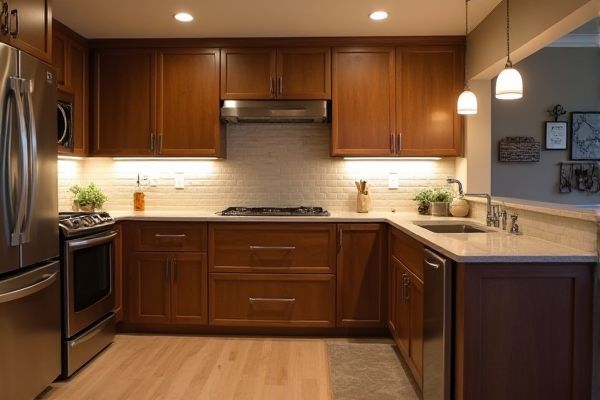
Under-cabinet lighting provides targeted illumination ideal for task areas like kitchen counters, enhancing visibility without shadows, while ceiling lighting offers broader, ambient light that brightens an entire room. Discover how to choose the best lighting solution for your space and needs by reading the rest of the article.
Table of Comparison
| Feature | Under-Cabinet Lighting | Ceiling Lighting |
|---|---|---|
| Purpose | Task lighting for countertops and workspaces | General ambient room illumination |
| Installation | Mounted beneath cabinets; requires wiring or battery options | Installed on ceiling; involves electrical wiring and fixtures |
| Light Coverage | Focused, localized light on surfaces | Broad, overall room coverage |
| Energy Efficiency | Typically uses LED strips; low energy consumption | Varies by fixture; LED options improve efficiency |
| Design Impact | Enhances workspace visibility and aesthetics | Defines room ambiance and general lighting style |
| Flexibility | Adjustable angles and brightness in some models | Limited adjustability, unless using dimmers or smart bulbs |
| Cost | Generally affordable; installation varies | Varies widely; can be higher due to fixture and installation |
Introduction to Under-Cabinet and Ceiling Lighting
Under-cabinet lighting provides focused illumination directly onto countertops, enhancing task visibility and adding aesthetic appeal in kitchens or workspaces. Ceiling lighting offers broader, ambient light that uniformly brightens entire rooms, creating an overall balanced atmosphere. Your lighting choices significantly impact functionality and mood, making the blend of both options ideal for optimal efficiency and design.
Key Differences Between Under-Cabinet and Ceiling Lighting
Under-cabinet lighting provides focused illumination directly on countertops, enhancing task visibility for cooking and food preparation, while ceiling lighting offers broader ambient light to brighten the entire room. Under-cabinet fixtures are typically compact, energy-efficient, and ideal for reducing shadows in workspaces, whereas ceiling lights vary in style and intensity, serving as the primary light source. Choosing under-cabinet lighting can improve your kitchen's functionality by targeting specific areas, while ceiling lighting supports overall room ambiance and general illumination needs.
Benefits of Under-Cabinet Lighting
Under-cabinet lighting enhances task visibility by directly illuminating countertops, reducing shadows and eye strain during cooking or detailed work. Its energy-efficient LED options offer targeted brightness without heating the room, contributing to lower electricity bills and a cooler kitchen environment. You gain a sleek, modern aesthetic that boosts kitchen ambiance while maximizing functional workspace lighting.
Advantages of Ceiling Lighting
Ceiling lighting offers broad illumination that effectively brightens entire rooms, making it ideal for general visibility and creating an evenly lit environment. It often integrates with dimmers and smart home systems to provide customizable lighting levels and enhance energy efficiency. Ceiling lighting fixtures come in diverse styles and sizes, enabling seamless integration with various interior designs while keeping surfaces and workspaces uncluttered.
Energy Efficiency Comparison
Under-cabinet lighting typically uses LED or low-wattage bulbs, consuming significantly less energy compared to traditional ceiling lighting fixtures. Ceiling lighting often requires higher wattage bulbs to illuminate larger areas, which can lead to increased electricity usage and higher utility bills. Choosing under-cabinet lighting for task-specific areas can enhance your home's overall energy efficiency by reducing unnecessary power consumption.
Installation and Maintenance Requirements
Under-cabinet lighting requires precise installation often involving drilling and electrical wiring within confined spaces, which may necessitate professional assistance for safety and optimal light placement. Ceiling lighting installations are generally less complex, with standard mounting procedures compatible with existing fixtures and direct access to electrical boxes. Maintenance for under-cabinet lighting involves periodic cleaning and bulb replacements in hard-to-reach areas, while ceiling lights offer easier access for bulb changes and cleaning, though they may require ladder use depending on ceiling height.
Best Spaces for Under-Cabinet Lighting
Under-cabinet lighting is ideal for kitchens, providing focused illumination on countertops for tasks like chopping and cooking, enhancing both safety and efficiency. Bathrooms benefit from under-cabinet lighting by reducing shadows around mirrors, improving grooming visibility. These lights also enhance workspace areas in offices or workshops with targeted brightness, unlike ceiling lighting which offers broader but less precise illumination.
Ideal Rooms for Ceiling Lighting
Ceiling lighting is ideal for larger rooms such as living rooms, kitchens, and dining areas where broad, even illumination is essential for functionality and ambiance. It efficiently lights up open spaces, providing sufficient brightness for activities, entertaining, and general use. Fixtures like recessed lights, chandeliers, and flush mounts enhance the overall aesthetic while ensuring comprehensive light coverage.
Cost Considerations and Budget Planning
Under-cabinet lighting typically costs less in terms of materials and installation compared to ceiling lighting, making it a budget-friendly option for localized illumination. Ceiling lighting requires larger fixtures and more extensive wiring, which can increase both initial expenses and maintenance costs over time. Budget planning should factor in the long-term energy efficiency and potential replacement frequency of bulbs for each lighting type to optimize overall cost savings.
Choosing the Right Lighting Solution for Your Home
Under-cabinet lighting provides targeted illumination ideal for kitchen countertops, enhancing task visibility and creating an inviting ambiance, while ceiling lighting offers broad, general illumination suitable for overall room brightness. Your choice depends on the specific needs of each space: under-cabinet lights optimize work areas, whereas ceiling fixtures ensure uniform light coverage throughout the room. Integrating both solutions can maximize functionality and aesthetic appeal in your home's lighting design.
 homyna.com
homyna.com